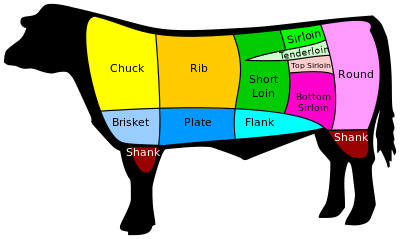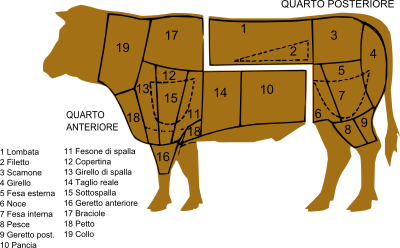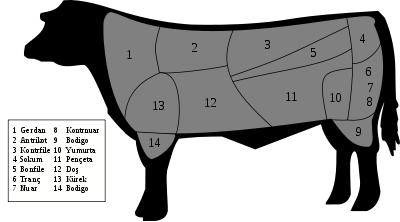
A beefsteak, often called just steak, is a flat cut of beef with parallel faces, usually cut perpendicular to the muscle fibers. In common restaurant service a single serving has a raw mass ranging from 120 to 600 grams. Beef steaks are usually grilled, pan-fried, or broiled. The more tender cuts from the loin and rib are cooked quickly, using dry heat, and served whole. Less tender cuts from the chuck or round are cooked with moist heat or are mechanically tenderized.

Lamb, hogget, and mutton, generically sheep meat, are the meat of domestic sheep, Ovis aries. A sheep in its first year is a lamb and its meat is also lamb. The meat from sheep in their second year is hogget. Older sheep meat is mutton. Generally, "hogget" and "sheep meat" are not used by consumers outside Norway, New Zealand, South Africa, Scotland, and Australia. Hogget has become more common in England, particularly in the North often in association with rare breed and organic farming.
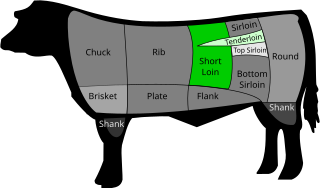
The T-bone and porterhouse are steaks of beef cut from the short loin. Both steaks include a "T"-shaped lumbar vertebra with sections of abdominal internal oblique muscle on each side. Porterhouse steaks are cut from the rear end of the short loin and thus include more tenderloin steak, along with a large strip steak. T-bone steaks are cut closer to the front, and contain a smaller section of tenderloin. The smaller portion of a T-bone, when sold alone, is known as a filet mignon, especially if cut from the small forward end of the tenderloin.

A beef tenderloin, known as an eye fillet in Australasia, filet in France, filé mignon in Brazil, and fillet in the United Kingdom and South Africa, is cut from the loin of beef.
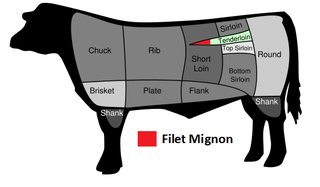
Filet mignon is a cut of meat taken from the smaller end of the tenderloin, or psoas major of a cow. In French, it mostly refers to cuts of pork tenderloin.

In American butchery, the sirloin steak is cut from the sirloin, the subprimal posterior to the short loin where the T-bone, porterhouse, and club steaks are cut. The sirloin is divided into several types of steak. The top sirloin is the most prized of these and is specifically marked for sale under that name. The bottom sirloin, which is less tender and much larger, is typically marked for sale simply as "sirloin steak". The bottom sirloin, in turn, connects to the sirloin tip roast.

The strip steak is a cut of beef steaks from the short loin of a cow. It consists of a muscle that does little work, the longissimus, making the meat particularly tender, although not as tender as the nearby psoas major or tenderloin. Unlike the tenderloin, the longissimus is a sizable muscle, allowing it to be cut into larger portions.
Sir Loin, sirloin, or variant, may refer to:

Pork ribs are a cut of pork popular in Western and Asian cuisines. The ribcage of a domestic pig, meat and bones together, is cut into usable pieces, prepared by smoking, grilling, or baking – usually with a sauce, often barbecue – and then served.
The loins, or lumbus, are the sides between the lower ribs and pelvis, and the lower part of the back. The term is used to describe the anatomy of humans and quadrupeds, such as horses, pigs, or cattle. The anatomical reference also applies to particular cuts of meat, including tenderloin or sirloin steak.

Chuck steak is a cut of beef and is part of the sub-prime cut known as the chuck.

A round steak is a beef steak from the "round", the rear leg of the cow. The round is divided into cuts including the eye (of) round, bottom round, and top round, with or without the "round" bone (femur), and may include the knuckle, depending on how the round is separated from the loin. This is a lean cut and it is moderately tough. Lack of fat and marbling makes round dry out when cooked with dry-heat cooking methods like roasting or grilling. Round steak is commonly prepared with slow moist-heat methods including braising, to tenderize the meat and maintain moisture. The cut is often sliced thin, then dried or smoked at low temperature to make jerky.
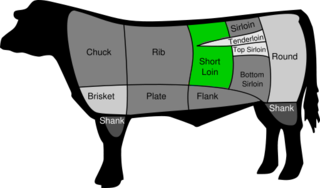
Short loin is the American name for a cut of beef that comes from the back of the cattle. It contains part of the spine and includes the top loin and the tenderloin. This cut yields types of steak including porterhouse, strip steak, and T-bone. The T-bone is a cut that contains less of the tenderloin than does the porterhouse. Webster's Dictionary defines it as "a portion of the hindquarter of beef immediately behind the ribs that is usually cut into steaks." The short loin is considered a tender beef.

Top sirloin is a cut of beef from the primal loin or subprimal sirloin. Top sirloin steaks differ from sirloin steaks in that the bone and the tenderloin and bottom round muscles have been removed; the remaining major muscles are the gluteus medius and biceps femoris.

A primal cut or cut of meat is a piece of meat initially separated from the carcass of an animal during butchering. Examples of primals include the round, loin, rib, and chuck for beef or the ham, loin, Boston butt, and picnic for pork.

Korean barbecue is a popular method in Korean cuisine of grilling meat, typically beef, pork or chicken. Such dishes are often prepared on gas or charcoal grills built into the dining table itself. Some Korean restaurants that do not have built-in grills provide customers with portable stoves for diners to use at their tables. Alternatively, a chef uses a centrally displayed grill to prepare dishes that are made to order.

The cuts of pork are the different parts of the pig which are consumed as food by humans. The terminology and extent of each cut varies from country to country. There are between four and six primal cuts, which are the large parts in which the pig is first cut: the shoulder, loin, belly and leg. These are often sold wholesale, as are other parts of the pig with less meat, such as the head, feet and tail. Retail cuts are the specific cuts which are used to obtain different kinds of meat, such as tenderloin and ham. There are at least 25 Iberian pork cuts, including jamón.

A steak is a thick cut of meat generally sliced across the muscle fibers, sometimes including a bone. It is normally grilled or fried. Steak can be diced, cooked in sauce, such as in steak and kidney pie, or minced and formed into patties, such as hamburgers.
Beef alternative merchandising is a method of fabricating sirloins, strip loins, and ribeyes into smaller cuts of meat created by the beef checkoff. The system was designed to appeal to consumers who are concerned about the portion sizes of these three cuts by dividing them into smaller steaks based on the individual muscles that compose the larger steaks. These cuts have an added bonus of reducing the cost of the meat for the consumer while simultaneously increasing profits for the butcher.

Baseball steak is a center cut of beef taken from the top sirloin cap steak. Baseball steaks differ from sirloin steaks in that the bone and the tenderloin and bottom round muscles have been removed; and the cut is taken from biceps femoris. A baseball steak is essentially a center cut top sirloin cap steak. This cut of beef is very lean, and is considered very flavorful.

